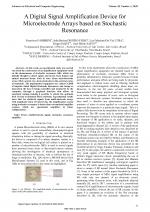| 3/2020 - 4 |
A Digital Signal Amplification Device for Microelectrode Arrays based on Stochastic ResonanceFAMBRINI, F. |
| Extra paper information in |
| Click to see author's profile in |
| Download PDF |
Author keywords
multielectrode, signal, stochastic, resonance, amplifier
References keywords
stochastic(29), resonance(26), review(11), noise(9), systems(6), physics(6), physical(6), signal(5), iecon(5), system(4)
Blue keywords are present in both the references section and the paper title.
About this article
Date of Publication: 2020-08-31
Volume 20, Issue 3, Year 2020, On page(s): 31 - 40
ISSN: 1582-7445, e-ISSN: 1844-7600
Digital Object Identifier: 10.4316/AECE.2020.03004
Web of Science Accession Number: 000564453800004
SCOPUS ID: 85090348231
Abstract
In this work, an experimental study was carried out about the construction of an amplification equipment based on the phenomenon of stochastic resonance (SR), which was initially thought to detect spikes and bursts from human and animal neuronal tissue, both in vitro (from microelectrode array, MEA) and in vivo, from electrodes in the cerebral cortex of mammals. The implemented equipment was called CADSR (Computer-Aided Digital Stochastic Resonator) and brings as innovation the fact of being controlled and monitored by the computer, through a graphical interface that allows an automatic tuning, making it possible to obtain the optimum level of noise to maintain SR in real-time. Experimental results show that for electrical signals from multi-electrode arrays with amplitude below 25 microvolts, the amplification system using stochastic resonance is better than conventional amplifier systems, which use operational amplifiers in linear configurations. |
| References | | | Cited By |
Web of Science® Times Cited: 1 [View]
View record in Web of Science® [View]
View Related Records® [View]
Updated 2 weeks, 6 days ago
SCOPUS® Times Cited: 1
View record in SCOPUS® [Free preview]
View citations in SCOPUS® [Free preview]
[1] A novel coupled two-dimensional unsaturated asymmetric bistable stochastic resonance system for bearing fault detection, Zhang, Gang, Zhu, Xingyu, Jiang, Zhongjun, Measurement, ISSN 0263-2241, Issue , 2022.
Digital Object Identifier: 10.1016/j.measurement.2022.111480 [CrossRef]
Disclaimer: All information displayed above was retrieved by using remote connections to respective databases. For the best user experience, we update all data by using background processes, and use caches in order to reduce the load on the servers we retrieve the information from. As we have no control on the availability of the database servers and sometimes the Internet connectivity may be affected, we do not guarantee the information is correct or complete. For the most accurate data, please always consult the database sites directly. Some external links require authentication or an institutional subscription.
Web of Science® is a registered trademark of Clarivate Analytics, Scopus® is a registered trademark of Elsevier B.V., other product names, company names, brand names, trademarks and logos are the property of their respective owners.
Faculty of Electrical Engineering and Computer Science
Stefan cel Mare University of Suceava, Romania
All rights reserved: Advances in Electrical and Computer Engineering is a registered trademark of the Stefan cel Mare University of Suceava. No part of this publication may be reproduced, stored in a retrieval system, photocopied, recorded or archived, without the written permission from the Editor. When authors submit their papers for publication, they agree that the copyright for their article be transferred to the Faculty of Electrical Engineering and Computer Science, Stefan cel Mare University of Suceava, Romania, if and only if the articles are accepted for publication. The copyright covers the exclusive rights to reproduce and distribute the article, including reprints and translations.
Permission for other use: The copyright owner's consent does not extend to copying for general distribution, for promotion, for creating new works, or for resale. Specific written permission must be obtained from the Editor for such copying. Direct linking to files hosted on this website is strictly prohibited.
Disclaimer: Whilst every effort is made by the publishers and editorial board to see that no inaccurate or misleading data, opinions or statements appear in this journal, they wish to make it clear that all information and opinions formulated in the articles, as well as linguistic accuracy, are the sole responsibility of the author.



